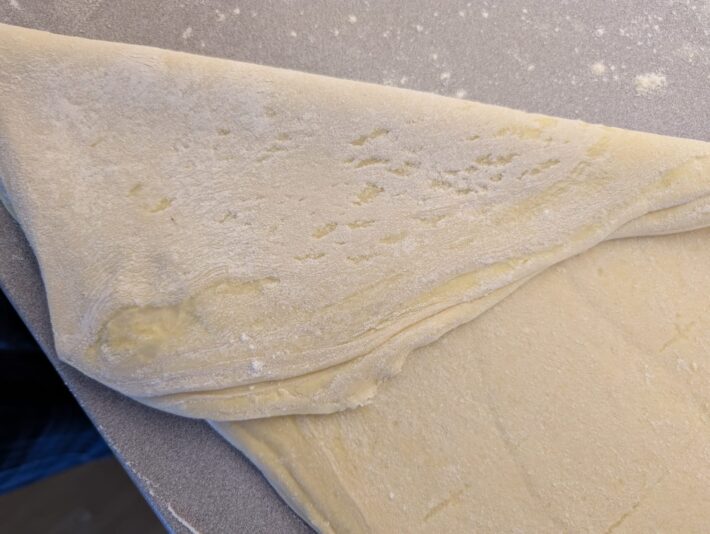Scoolinary › Forums › Ask a question › Antonio Bachours croissant course issues
Tagged: Butter croissant dough
-
Antonio Bachours croissant course issues
Posted by otto.lindqvist on January 12, 2025 at 11:05Hi all. I’m trying to achieve croissants with Antonio Bachours course but for some reason I cant get the dough to be strong enough. Do you have any tips on how to get it to hold during laminaion? Is my dough under or over knead? Am I using wrong flour? I used italian 00 pizza flour. In finland it is quite difficult to find out t value of the flour but it has 12% protein
Sussan Estela Olaya replied 3 months, 2 weeks ago 4 Members · 4 Replies -
4 Replies
-
Level:
 Scoolinary Team
Scoolinary Team
Hi Otto Lindqvist
Hi, thank you for sharing your experience and photos. Based on what you’ve described and the images, it seems the issue might be related to the flour and kneading. In the course, it’s mentioned that it’s ideal to use flour with a protein content between 12% and 13% and a PL value of 0.4 to 0.7, as this ensures a good balance between elasticity and strength for lamination.
The Italian 00 pizza flour you’re using has 12% protein, which is at the lower end of the recommended range. However, its PL value might not be suitable for laminated doughs, as these types of flour are usually more elastic and less resistant.
Here are some recommendations that might help:
Check your kneading: Make sure not to under-knead or over-knead the dough. It should develop enough gluten to be elastic but not so tight that it tears easily during lamination. Perform the windowpane test to check if the gluten is properly developed.
Switch flours: If possible, try to find flour with the specifications mentioned in the course (12%–13% protein and a PL value of 0.4–0.7). If you can’t find this information in Finland, strong bread flour or Manitoba flour could be a good alternative.
Handle the dough carefully: Ensure the dough is well-chilled during lamination. This helps maintain its structure and prevents the butter from incorporating into the dough.
Rest between folds: If the dough feels too elastic and shrinks back when rolling it out, give it more resting time in the fridge between folds to relax the gluten.
Try these adjustments and let us know how it goes. I hope this information he
lps.
Best regards!
-
I’d like to know what is that pL.
Andits recommended to knead it in speed 3,after 7 minutes of kneading.
But my Kenwood recommendation is to knead up to 1,in order not to damage the mixer.
What should I do?
Thanks 😊
-
Level:
 Scoolinary Team
Scoolinary Team
Hi רות בביוף
Here are the answers to your questions:
What is the pL of the flour?
The pL is a parameter that measures the relationship between the extensibility and tenacity of the dough (its ability to stretch and resist). This data is part of the rheological properties of the flour and is evaluated using a Chopin alveograph. A balanced pL, around 0.5-0.6, indicates a flour ideal for laminated doughs like croissants. If the pL is higher, the dough will be more tenacious (less extensible), and if it is lower, it will be too extensible and difficult to handle.
About kneading speed:
The recipe suggests kneading at speed 3 after 7 minutes, but if your Kenwood recommends not exceeding speed 1 to avoid damage, it’s best to follow the manufacturer’s guidelines.
Recommendation:
This recipe is designed for professional machines, which have more powerful motors and larger capacity. Stand mixers or home machines like Kenwood or KitchenAid are not ideal for doughs requiring long kneading times to develop a strong gluten network.
It’s not impossible to use your Kenwood, but to ensure the machine doesn’t get damaged, it’s recommended to combine kneading in your mixer with manual kneading. Start in the mixer at speed 1 until the dough comes together, and then continue kneading by hand until the desired elasticity is achieved.
I hope this information is helpful.
Best regards!
-
-
-
Level:
 Scoolinary Team
Scoolinary Team
Hey there Otto!👋
Welcome to the Scoolinary Community! 😊Join our awesome group of food lovers and share your love of cooking. Everyone’s invited!
I’m Sol Damiani, the Community Builder and I’m from Buenos Aires.
I hope Sussan’s answer helped you. Please let us know if it did. It’s a tough path to accomplish great croissants but I’m confindent you’ll conquer it!
This is a Community that values your participation a lot: that’s why we created “Masters Game”
-
Win Scoolipoints by sharing a pic of your own dishes in our Community > Cooking Feed section. If it is really cool you can snag a #ScooliStar: you’ll win 100 Scoolipoints and we’ll give you a shoutout on social media!🤩
-
🏆Check out our Challenges and score Scoolipoints! Right now we have the #PokeChallenge going on and you can win 250 scoolipoints. Make sure to join!
-
You’ll see everything you need to know about how to win Scoolipoints here.
Let’s build a community of foodies together.
We hope you have a blast learning with Scoolinary!
-
Log in to reply.




